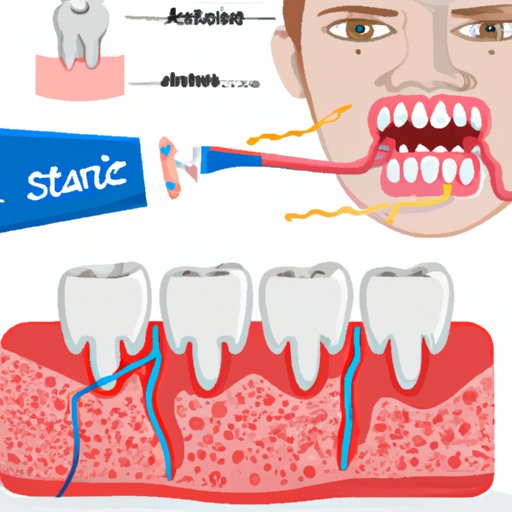
I. Introduction
If you recently had a tooth extracted, you may have heard of the dreaded “dry socket” – a common complication that can cause severe pain and discomfort. Dry socket occurs when the blood clot that forms in the socket after a tooth extraction becomes dislodged or dissolves, leaving the underlying bone and nerves exposed. Although dry socket is not a serious condition, it can be incredibly painful and affect your quality of life. Read on to learn more about how to identify dry socket, and what you can do to prevent and treat it.
II. Symptoms to Watch Out For
The most obvious symptom of dry socket is severe pain in the affected area, which can radiate to the ear, temple, and other parts of the head. Other symptoms include:
- Foul taste and odor in the mouth: As the blood clot dissolves, it can release a foul smell and taste in your mouth.
- Partial or total loss of the blood clot: You may feel a hole in the socket where the clot is missing.
- Swelling and inflammation in the gum tissue: The gum tissue around the affected area may appear swollen, red, and painful to the touch.
If you experience any of these symptoms, it’s critical to seek advice from a dentist or oral surgeon right away. They can help diagnose the condition and provide appropriate treatment to relieve your symptoms.
III. Causes and Prevention
Several factors can increase the risk of getting a dry socket, such as smoking, using oral contraceptives, poor dental hygiene, and having a tooth extracted from the lower jaw. Fortunately, there are several steps you can take to prevent dry sockets from happening:
- Avoid drinking through a straw: Suction can dislodge the blood clot, leading to dry socket.
- No smoking: Smoking is known to delay healing and increase the risk of dry socket.
- Talk to your dentist about your medications: If you’re taking medications that thin the blood, like aspirin or anticoagulants, let your dentist know as this can increase your risk of getting a dry socket.
- Eat a soft food diet: Make sure you eat soft foods like yogurt, eggs, and soup after a tooth extraction as harder foods can dislodge the blood clot.
Precautionary measures can help decrease the risk of getting dry socket, but it is not always avoidable. If you experience dry socket despite taking these precautions, seek immediate help from a dentist or oral surgeon.
IV. Common Myths
There are several misconceptions about dry socket, and these myths can be harmful if you rely on them instead of seeking professional help. Here are some of the most common dry socket myths debunked:
- Myth 1: Dry socket is a rare occurrence. This is not true. Although not everyone gets dry socket, it is still quite common after a tooth extraction.
- Myth 2: Dry socket cannot be treated. This is false. There are several treatment options available to relieve the discomfort and promote healing.
- Myth 3: Dry socket only happens in older patients. This is not true. Dry socket can happen to anyone, regardless of age.
Believing in these myths can prevent you from getting the appropriate care you need, so always seek help from a dentist or oral surgeon if you suspect you may have dry socket.
V. Home Remedies
There are several home remedies you can try to alleviate the pain and discomfort caused by a dry socket. Here are some popular natural remedies:
- Clove oil: Clove oil has anti-inflammatory and analgesic properties and can help to relieve pain in the affected area. Simply apply a small amount of clove oil to the affected tooth with a cotton swab.
- Tea bag: Tea bags have tannins that can help to alleviate pain and swelling. Place a wet tea bag on the affected area for 30 minutes and repeat until the pain subsides.
- Warm saltwater rinse: Rinsing your mouth with warm salt water can help to alleviate pain and inflammation in the affected area.
While these remedies may help to reduce the pain, they are not a substitute for professional dental care. Always seek help from a dentist or oral surgeon if your symptoms persist, or if you experience any side effects after using natural remedies.
VI. When to See a Dentist
If you experience any of the symptoms of dry socket, it’s critical to schedule an appointment with your dentist or oral surgeon as soon as possible. They can evaluate your condition and provide appropriate treatment to alleviate your symptoms. Treatment may include:
- Pain medication: Over-the-counter pain relievers like ibuprofen or aspirin can help to reduce pain and inflammation.
- Dressing: Your dentist may place a medicated dressing or packing inside the socket to promote healing.
- Antibiotics: In rare cases, your dentist may prescribe antibiotics to prevent infection.
The longer you postpone treatment, the more discomfort you may experience, and the slower the healing process will be. It’s essential to seek help from a dental professional as soon as possible if you suspect you have a dry socket.
VII. Conclusion
Knowing how to identify dry socket and seek appropriate treatment is critical to your oral and general health. Dry socket can be incredibly painful, and without timely intervention, it can interfere with your quality of life. By following preventive measures, seeking timely treatment, and debunking common myths, you can protect yourself from dry socket and enjoy a healthy oral environment.
Remember, if you experience any of the symptoms of dry socket, don’t hesitate to contact your dentist or oral surgeon for a comprehensive evaluation.




